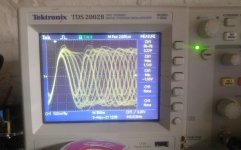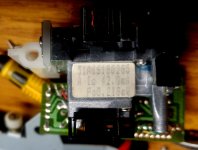Excellent choice.
I have four CD players with Philips swing-arm optical pickups sitting next to my workbench. When time permits (hopefully very soon) I will test them and post photos of their eye patterns.
-EB
I'll wait for those images before I attempt to get my DSO to generate a working pattern,
Thanks,
George
Eye pattern for 35-year-old Onkyo DX-120 CD player, observed with Tektronix TDS2002B digital oscilloscope:

It will probably look much cleaner when viewed with an analog CRT oscilloscope. It's difficult to configure the "persistence" feature of a DSO to emulate a CRT. Eye patterns viewed with digital scopes often look "noisier" due to random pixelation.
I'll set up an analog scope soon for comparison. My DSO takes up very little space on my crowded workbench. Plus it is simple to copy screen images and raw data files onto a PC for detailed analysis. So I rely on it. My analog scope only gets used occasionally. Right now I'm thinking that viewing eye patterns is a good reason to bring an analog scope back to my workbench for a while.
The most important item to observe from viewing the eye pattern with a DSO is its peak-to-peak amplitude. Digital scopes do a great job with amplitude measurement. For example my Tektronix TDS2002B measures and displays the P-P amplitude of the eye pattern in real time (3.22V P-P for the attached screenshot).
-EB

It will probably look much cleaner when viewed with an analog CRT oscilloscope. It's difficult to configure the "persistence" feature of a DSO to emulate a CRT. Eye patterns viewed with digital scopes often look "noisier" due to random pixelation.
I'll set up an analog scope soon for comparison. My DSO takes up very little space on my crowded workbench. Plus it is simple to copy screen images and raw data files onto a PC for detailed analysis. So I rely on it. My analog scope only gets used occasionally. Right now I'm thinking that viewing eye patterns is a good reason to bring an analog scope back to my workbench for a while.
The most important item to observe from viewing the eye pattern with a DSO is its peak-to-peak amplitude. Digital scopes do a great job with amplitude measurement. For example my Tektronix TDS2002B measures and displays the P-P amplitude of the eye pattern in real time (3.22V P-P for the attached screenshot).
-EB
Eye pattern for 35-year-old Onkyo DX-120 CD player, observed with Tektronix TDS2002B digital oscilloscope:
View attachment 949080
It will probably look much cleaner when viewed with an analog CRT oscilloscope. It's difficult to configure the "persistence" feature of a DSO to emulate a CRT. Eye patterns viewed with digital scopes often look "noisier" due to random pixelation.
I'll set up an analog scope soon for comparison. My DSO takes up very little space on my crowded workbench. Plus it is simple to copy screen images and raw data files onto a PC for detailed analysis. So I rely on it. My analog scope only gets used occasionally. Right now I'm thinking that viewing eye patterns is a good reason to bring an analog scope back to my workbench for a while.
The most important item to observe from viewing the eye pattern with a DSO is its peak-to-peak amplitude. Digital scopes do a great job with amplitude measurement. For example my Tektronix TDS2002B measures and displays the P-P amplitude of the eye pattern in real time (3.22V P-P for the attached screenshot).
-EB
Thanks. Any tricks to get the trace to trigger correctly?
George
Here's how I set up my Tektronix TDS2002B:Thanks. Any tricks to get the trace to trigger correctly?
George
Use a "divide by 10" scope probe to avoid loading down the raw signal.
Select AC coupling for both signal and trigger.
Trigger mode should be "edge triggered" and "auto" to start with
If the scope has a bandwidth limiter for vertical channel (mine does) set it to 20MHz. This filters out extreme high frequency garbage and provides a sharper image.
After you get to the point of seeing the RF signal then switch the trigger to "normal." Auto trigger tends to blur it too much.
Adjust the trigger voltage level to a value near 0 (mid-screen).
The TEK DSO I have is easiest to adjust when the horizontal trigger point (trigger time actually) is positioned at the middle of the screen.
This permits changing the H time/div freely.
After selecting a suitable H time/div, then use the "H position control" to move the trigger time towards the left side of the screen.
This will produce a display similar to an analog scope.
Note that "H position" doesn't actually move the displayed trace across the screen like the way an analog scope behaves.
Rather it moves the trigger time in relationship to what is viewable on the screen.
If you wish to change the time/div it is best to first move the trigger point back to the middle of the screen before changing the time/div.
-EB
The Onkyo DX-120 service manual shows 3V P-P for the RF signal. That's what I'm getting from factory-stamped discs. I've also been able to play burned CD-R discs on this machine. They generate about 2.2V P-P of RF.Hi EB,
Amplitude looks high, unless that machine is supposed to be that high. Most run 1.5 Vp-p to 1.2 Vp-p.
Yes, not too bad, but the analogue scope will tell the tail. Your laser power may be adjusted way too high, and that causes trouble too.
-Chris
I haven't yet studied the relationship between RF level and the level required for the player's logic to detect "focus lock" during the focus search.
It's interesting to me that the only place where the Onkyo service manual mentions the uW light output level of the laser is in the flow-chart which explains how the player initializes a disc.
The flow chart says "uW >250" in the decision box where the presence of a disc is detected by the focus search.
At this time the spindle motor isn't rotating. Focus detection is accomplished by a comparator which looks at the DC-based signal from the ABCD detector diodes. It's threshold is "fixed" by the design of the RF and servo processing IC chip.
Another thing I intend to check is to determine whether resetting the laser mA back to the value on the sticker (42.9mA) results in the original IR light output level of 218 uW.

I'm thinking that if 42.9mA generates 218uW this would indicate the laser diode itself has no issues.
But I'm not certain wether the values on this sticker are correct for this CD player?
Perhaps that was a standardized QC test performed by the manufacturer of the optical pickup?
But not necessarily the correct amount of light output for the Onkyo DX-120?
Why would Onkyo readjust the pickup to a higher uW level?
(I'm always asking more questions)
When I perform this "42.9mA for 218uW" test I will also check to see whether the machine is still capable of initializing discs (or not) while the light amplitude is 218uW.
Also I haven't resolved another post on diyAudio which states "the desired IR light output for TAOHS-style optical pickups is 300-500uW"
-EB
My Tek TDS2002B has the "auto-set" button. I've used it occasionally as "a starting point" to get something to show on the screen."autoset" would have worked fine if your scope has it. Most newer ones do.
I'm not entirely happy that an accidental press of the "auto-set" button will erase a detailed setup that required several minutes of manual adjustments to get the display I wanted.
-EB
Hi EB,
 Keysight generally has a good user interface. My Philips PM3070 was easy to hit the autoset button on. Yes, that messed me up a few times.
Keysight generally has a good user interface. My Philips PM3070 was easy to hit the autoset button on. Yes, that messed me up a few times.
The value of current stamped on the head is accurate. It differs for each head. I always would select the head with the lowest Iop figure. They last longer.
Chris
Happens to all of us. Happily, the MSOX3104T I'm using has that button recessed, and it gives you to option to return to the old settings.I'm not entirely happy that an accidental press of the "auto-set" button will erase a detailed setup that required several minutes of manual adjustments to get the display I wanted.
The value of current stamped on the head is accurate. It differs for each head. I always would select the head with the lowest Iop figure. They last longer.
Chris
- Home
- Source & Line
- Digital Source
- Revox B226 Studer A727 repair